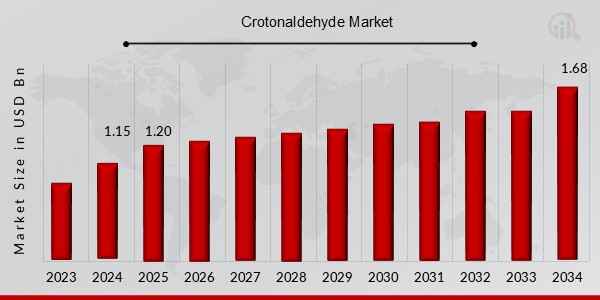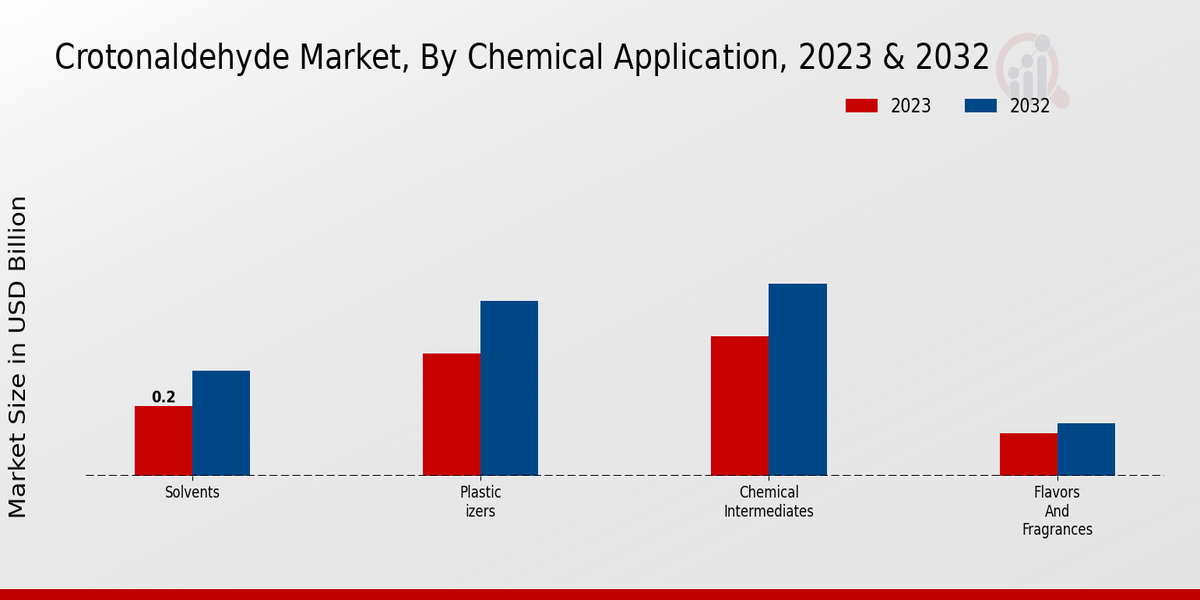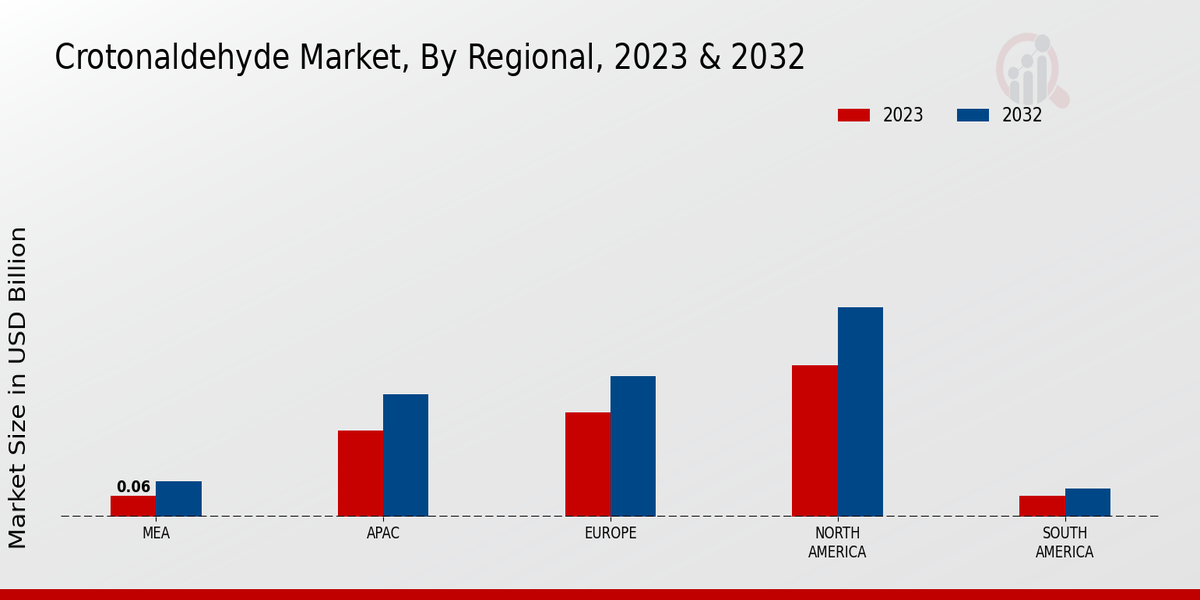Global Crotonaldehyde Market Overview
The crotonaldehyde market size was estimated at 1.15 (USD billion) in 2024. The crotonaldehyde industry is expected to grow from 1.20 (USD billion) in 2025 to1.68 (USD billion) by 2034. The crotonaldehyde market CAGR (growth rate) is expected to be around 3.8% during the forecast period (2025-2034).
Key Crotonaldehyde Market Trends Highlighted
The crotonaldehyde market is currently experiencing several significant drivers that are shaping its landscape. A principal market driver is the increasing demand for crotonaldehyde in the production of various chemicals, especially in the synthesis of butadiene, which is essential for the manufacture of synthetic rubber and plastics. The growing focus on developing bio-based products fuels the demand for crotonaldehyde as an essential intermediate in the production of agricultural chemicals and pharmaceuticals. This growing trend aligns with the broader shift towards sustainable and environmentally friendly production processes.There are numerous opportunities to be explored within this market, particularly in the realm of emerging applications of crotonaldehyde. As industries, including textiles and personal care, continue to expand, the demand for crotonaldehyde as a crucial intermediate for various formulations is set to rise. Furthermore, innovation in manufacturing processes that enhance efficiency could significantly reduce production costs and enhance profit margins for key players. The ongoing research into alternative sources of crotonaldehyde also presents growth opportunities, especially as companies look to diversify supply chains and improve sustainability profiles.Recent trends indicate an increasing emphasis on regulatory compliance and safety in chemical manufacturing, which is influential in shaping the crotonaldehyde market. Companies are becoming more cognizant of the need for transparency in their operations and product offerings. Additionally, collaborations and partnerships among industry stakeholders are on the rise, aiming to leverage collective strengths for technological advancements and to improve market positioning. Such alliances may facilitate a more agile response to evolving market dynamics and end-user demands, thereby boosting the overall growth potential of the crotonaldehyde market. As the landscape continues to evolve, players in this market remain focused on innovation and adaptation to meet the shifting needs of their customers.

Source: Primary Research, Secondary Research, MRFR Database and Analyst Review
Crotonaldehyde Market Drivers
Growing Demand from the Chemical Industry
The market is witnessing significant growth due to the increasing demand for crotonaldehyde from the chemical industry. Crotonaldehyde is a vital chemical intermediate used in the production of various chemicals and materials, including plastics, resins, and pharmaceuticals. As industries expand and evolve, the need for versatile chemical intermediates that can serve multiple applications becomes crucial. Furthermore, the rise in the production of specialty chemicals is driving up the demand for crotonaldehyde as a key ingredient.With the projected increase in market value over the coming years, businesses within the chemical sector are actively seeking reliable sources of crotonaldehyde to meet their production needs. The versatility of crotonaldehyde makes it an attractive choice for companies looking to innovate and improve their product lines. This trend is expected to continue, contributing to the expanding market as manufacturers strive to enhance efficiency, minimize costs, and meet evolving consumer preferences. The growth of the automotive and construction sectors, which often utilize chemical products derived from crotonaldehyde, further fuels the market's expansion, indicating a positive outlook for the crotonaldehyde industry.
Rising Production of Synthetic Rubber
The production of synthetic rubber is a significant factor driving the crotonaldehyde market. Synthetic rubber is widely utilized in various applications, including tires, automotive parts, and other industrial materials. As the automotive industry continues to grow, the demand for synthetic rubber increases correspondingly. Crotonaldehyde is an essential component in the synthesis of specific types of synthetic rubber, which bolsters its market demand. The consistent expansion of the automotive sector, driven by rising vehicle ownership and advancements in technology, further emphasizes the importance of crotonaldehyde in supporting this growth.
Increased Research and Development Activities
Research and development activities surrounding crotonaldehyde are becoming increasingly prominent, enhancing the crotonaldehyde market. Ongoing research is focused on optimizing production processes and discovering new applications for crotonaldehyde in various fields, such as pharmaceuticals and agrochemicals. Emphasis on research not only fosters innovation but also improves the efficiency and sustainability of crotonaldehyde production. As companies invest in developing eco-friendlier processes and applications, the market for crotonaldehyde is likely to flourish, as more businesses recognize the potential benefits derived from this chemical compound.
Crotonaldehyde Market Segment Insights
Crotonaldehyde Market Chemical Application Insights
The chemical application segment of the crotonaldehyde market has been fundamental in shaping the overall landscape of the industry. Several key areas stand out, including plasticizers, chemical intermediates, solvents, and flavors and fragrances, which are all integral to varied industrial applications. Plasticizers, valued at 0.35 USD billion in 2023 and expected to grow to 0.5 USD billion by 2032, maintain a dominant position due to their critical role in enhancing the flexibility and durability of polymer products. This growing demand for flexible materials in construction, automotive, and packaging sectors propels the significance of this area. Chemical intermediates, valued at 0.4 USD billion in 2023 and anticipated to rise to 0.55 USD billion by the end of the forecast period, are also crucial to manufacturing processes, serving as essential building blocks for a wide array of chemical products, thus fueling its notable growth. Solvents represent another important facet, holding a market value of 0.2 USD billion in 2023 and projected to increase to 0.3 USD billion in 2032; their usage in paints, coatings, and adhesives solidifies their relevance in the market. This growing application is tied closely to developments in the construction and automotive industries, where demand for high-quality finishes is increasing. Flavors and fragrances, while smaller in scale, valued at 0.12 USD billion in 2023 with an increase to 0.15 USD billion in 2032, contribute significantly to the consumer goods market, impacting flavor development in food and beverage as well as scent formulations in personal care products.

Source: Primary Research, Secondary Research, MRFR Database and Analyst Review
Crotonaldehyde Market Usage Insights
By industry usage, crotonaldehyde is utilized across sectors such as automotive, pharmaceuticals, food and beverage, agriculture, and textiles. The automotive segment plays a crucial role due to its application in producing synthetic rubber and resins, which are essential for vehicle manufacturing. The pharmaceutical industry benefits from crotonaldehyde's role as an intermediary in various drug formulations, enhancing the market's stability. The food and beverage sector uses it as a flavoring agent and preservative, reflecting its versatility. Agriculture leans on crotonaldehyde for pesticide production, which is vital for crop protection. Lastly, the textile industry utilizes this compound for producing fibers and dyes, reaffirming its significance across diverse applications.
Crotonaldehyde Market Formulation Type Insights
By formulation type, the crotonaldehyde market includes liquid crotonaldehyde and solid crotonaldehyde. Liquid crotonaldehyde plays a critical role due to its high demand in chemical synthesis and production processes, offering flexibility and efficiency for end-users. On the other hand, Solid Crotonaldehyde is significant in the market, frequently utilized in specific applications requiring stability and longevity.The ongoing trends such as advancements in synthetic methods and the exploration of new application areas continue to propel market growth. Alongside growth drivers like industrial expansion, fluctuations in raw material prices pose challenges that the market participants must navigate. However, opportunities arise from emerging markets and innovation in product formulations, paving the way for future advancements in the Crotonaldehyde Market revenue, as reflected in the Crotonaldehyde Market statistics.
Crotonaldehyde Market Production Method Insights
The production method segment includes three primary approaches, namely catalytic dehydrogenation of butyraldehyde, oxidation of butadiene, and dehydration of butanol. Catalytic dehydrogenation of Butyraldehyde remains significant due to its efficiency and ability to produce high-purity crotonaldehyde, serving key applications in various industries. Oxidation of butadiene is another pivotal method, primarily driven by its potential in producing a higher yield of crotonaldehyde, which is essential to produce plastics and synthetic fibers.Dehydration of butanol is gaining traction due to its relatively simple process and cost-effectiveness, making it an appealing option for production. As market growth trends continue through to 2032, the segment reflects the industry's evolving needs and the opportunity for advancements in production techniques, with expected growth fueled by increasing demands in end-use industries.
Crotonaldehyde Market End Product Type Insights
By end product type, resins are vital due to its extensive use in diverse sectors, highlighting its demand in the manufacturing of durable and efficient products. Adhesives also figure prominently, as they are essential in construction and automotive applications, reflecting a significant contribution to the market's growth drivers.Coatings represent another important facet, as they enhance the aesthetic appeal and functionality of products, and their widespread adoption in household and industrial applications underlines their pivotal role in the market. Personal care products are gaining traction, catering to consumer trends towards health and wellness, showcasing their importance in lifestyle applications.
Crotonaldehyde Market Regional Insights
North America holds a significant share at 0.42 USD billion in 2023, making it a dominant player in the market, primarily due to the developed chemical sector and increasing demand for specialty chemicals. Europe follows closely with a valuation of 0.29 USD billion, reflecting substantial industrial activity and stringent regulatory frameworks promoting safety and quality.Asia Pacific, valued at 0.24 USD billion, is rapidly emerging with notable growth prospects, driven by expanding manufacturing capabilities and a surge in consumer goods. The Middle East and Africa represent a smaller yet notable portion, valued at 0.06 USD billion, with potential growth stemming from industrial diversification efforts. South America is valued at 0.06 USD billion, showing limited but growing interest in chemical applications.

Source: Primary Research, Secondary Research, MRFR Database and Analyst Review
Crotonaldehyde Market Key Players and Competitive Insights
The crotonaldehyde market is characterized by intense competition, with various players leveraging their strengths to capture significant market shares. The demand for crotonaldehyde, an important chemical intermediate used in the production of various derivatives such as butyraldehyde, crotonic acid, and more is a key driver of this market. Companies in this sector are focusing on innovation, expansion of production capabilities, and strategic partnerships to enhance their competitive edge. The market dynamics are influenced by factors such as advancements in production technology, raw material availability, regulatory compliance, and sustainability initiatives. Competitive intelligence in this sphere is crucial for businesses seeking to maintain their market position and explore growth opportunities in emerging regions, while also navigating the challenges associated with new entrants and changing consumer preferences.Invista is recognized for its strong presence in the crotonaldehyde market, significantly contributing to the overall industry landscape. The company benefits from a robust supply chain and efficient production processes that enable it to deliver high-quality crotonaldehyde products. Invista's technological prowess is a notable strength, as it continuously invests in research and development to enhance its product offerings and optimize production efficiency. The company’s commitment to sustainable practices, including reducing emissions and waste in manufacturing processes, resonates well with the growing demand for eco-friendly chemicals. Moreover, Invista's strategic collaborations with key stakeholders in various industries further solidify its competitive position, allowing it to effectively address evolving customer needs and expand its market reach.Kraton Corporation also plays a significant role in the market, leveraging its extensive experience and expertise in chemical manufacturing. The company is recognized for its capacity to produce high-quality products through innovative approaches to production and a strong emphasis on continuous improvement.Kraton’s focus on research and development has led to the formulation of advanced products that cater to a diverse range of applications, enhancing its market appeal. The company’s established distribution networks and reach ensure that its products are readily available to a wide customer base, further solidifying its position in the market. Kraton Corporation is committed to sustainability, emphasizing the importance of environmental stewardship in its operations, which aligns well with current trends in the chemical industry. This strategic focus on innovation, quality, and sustainability equips Kraton to thrive and compete effectively within the crotonaldehyde market.
Key Companies in the Crotonaldehyde Market Include
Crotonaldehyde Market Developments
Recent developments in the crotonaldehyde market indicate a steady growth trajectory, driven by increased demand in various applications, such as in the synthesis of agrochemicals, plastics, and pharmaceuticals. In 2024, the market is projected to be valued at approximately USD 1.07 billion, with expectations of reaching USD 1.5 billion by 2032, highlighting a CAGR of 3.83%. Factors contributing to this growth include advancements in production technologies and rising investments in RD initiatives. There is an increasing focus on environmental regulations, prompting manufacturers to adopt more sustainable practices in crotonaldehyde production. Emerging economies are also playing a pivotal role in market dynamics, as industrialization and urbanization drive demand. Geopolitical tensions and supply chain disruptions are influencing market patterns, leading companies to reassess their operational strategies. As the market evolves, stakeholders are focusing more on innovation and sustainability to align with changing consumer preferences and regulatory requirements, shaping the future landscape of the crotonaldehyde industry.
Crotonaldehyde Market Segmentation Insights
Crotonaldehyde Market Chemical Application Outlook
-
Plasticizers
-
Chemical Intermediates
-
Solvents
-
Flavors and Fragrances
Crotonaldehyde Market Usage Outlook
-
Automotive
-
Pharmaceuticals
-
Food and Beverage
-
Agriculture
-
Textiles
Crotonaldehyde Market Formulation Type Outlook
-
Liquid Crotonaldehyde
-
Solid Crotonaldehyde
Crotonaldehyde Market Production Method Outlook
Crotonaldehyde Market End Product Type Outlook
-
Resins
-
Adhesives
-
Coatings
-
Personal Care Products
Crotonaldehyde Market Regional Outlook
-
North America
-
Europe
-
South America
-
Asia Pacific
-
Middle East and Africa
| Report Attribute/Metric |
Details |
| Market Size 2024 |
1.15 (USD Billion) |
| Market Size 2025 |
1.20 (USD Billion) |
| Market Size 2034 |
1.68 (USD Billion) |
| Compound Annual Growth Rate (CAGR) |
3.8% (2025-2034) |
| Report Coverage |
Revenue Forecast, Competitive Landscape, Growth Factors, and Trends |
| Base Year |
2024 |
| Market Forecast Period |
2025-2034 |
| Historical Data |
200-2024 |
| Market Forecast Units |
USD Billion |
| Key Companies Profiled |
Invista, Kraton Corporation, Jilin Chemical Industrial, Taminco, Eastman Chemical Company, Oxea GmbH, Mitsubishi Chemical, Nippon Shokubai, Gulshan Polyols, Royal Dutch Shell, Asahi Kasei Corporation, Wacker Chemie AG, Huntsman International, BASF, Fujian Petrochemical Company |
| Segments Covered |
Chemical Application, Industry Usage, Formulation Type, Production Method, End Product Type, Region |
| Key Market Opportunities |
Rising demand in chemical synthesis Growth in agrochemical applications Increasing use in perfumes and flavors Expansion in plastic manufacturing Innovative applications in pharmaceuticals |
| Key Market Dynamics |
Growing industrial applications Rising demand for chemical intermediates Increasing regulatory focus on safety Fluctuating raw material prices Expanding end use industries |
| Countries Covered |
North America, Europe, APAC, South America, MEA |
Frequently Asked Questions (FAQ) :
The crotonaldehyde market is expected to be valued at 1.68 USD billion in 2034.
The expected CAGR for the Crotonaldehyde Market from 2025 to 2034 is 3.8%.
North America is anticipated to hold the largest market share, valued at 0.58 USD billion in 2032.
The plasticizers segment is expected to be valued at 0.5 USD billion in 2032.
Major players in the market include Invista, Kraton Corporation, and Eastman Chemical Company.
The chemical intermediates segment is expected to be valued at 0.55 USD billion in 2032.
The solvents segment of the Crotonaldehyde Market is projected to be valued at 0.3 USD billion in 2032.
The crotonaldehyde market in the Asia Pacific is expected to grow to 0.34 USD billion by 2032.
The flavors and fragrances segment is expected to reach a market value of 0.15 USD billion in 2032.
The market in Europe is anticipated to be valued at 0.39 USD billion in 2032.
















